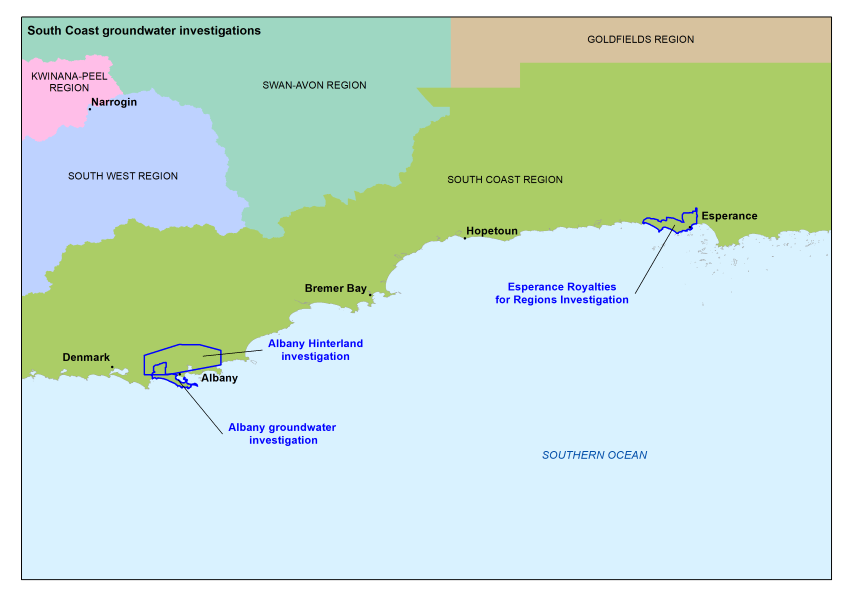South Coast groundwater investigation
Water demand in the Great Southern region is increasing at the same time as rainfall is decreasing due to climate change. These dual pressures are putting strain on our water resources, which are used for public water supply, agriculture, industry, and stock and domestic purposes.
We investigated three priority areas of the South Coast, including:
- The Albany groundwater area, which provides over 90 per cent of drinking water for the Lower Great Southern town water supply scheme.
- The Albany hinterland, north and west of Albany, where there is interest in water for new or expanded agriculture and other business.
- Esperance, where improved groundwater information was required to confirm the availability of groundwater for future population growth.
These investigations have secured and optimised groundwater resources to support regional development, build better management tools, and enable the government to make cost-effective decisions.
These investigations were funded by the Royalties for Regions Regional Water Availability program.
What we did during the investigation
As part of this investigation we:
- drilled 16 exploratory bores totalling 1,220 metres and constructed two monitoring bores in the Albany hinterland
- collected 8,810 square kilometres of airborne electromagnetic (AEM) data over the Albany groundwater area and hinterland
- collected and analysed samples from 58 bores, eight rainfall sites and ocean water in the Albany groundwater area
- produced a detailed map outlining prospective zones, depth to water, expected quality and potential quantity of water resources in paleochannels in the Albany hinterland area
- built a 3D digital conceptual model of the Albany groundwater area, used to create the Albany Aquifer Modelling System numerical groundwater model
- collected 540 square kilometres of airborne electromagnetic (AEM) data over the Esperance groundwater area
- collected and analysed samples from 30 bores and nine rainfall sites in the Esperance groundwater area
- built a 3D digital conceptual model of the Esperance groundwater area.
Key findings and how we are using the information
We ran predictive scenarios in the Albany Aquifer Modelling System to evaluate the impacts of future climate and water supply borefield development. We increased the volume of groundwater for Albany and the Lower Great Southern town water supply scheme to meet future demand to 2030.
In the Albany hinterland, we defined four prospective palaeochannel resources in the King River, Kalgan River, Manypeaks and Nanarup areas.
We revised the Esperance groundwater areas management plan using information from our investigation. We implemented improved management and monitoring to prevent saline intrusion to the aquifer and are moving abstraction away from high-risk areas. This project has confirmed the availability of groundwater to support the predicted population growth and ensured the quality of the resource is protected and enhanced.
Where to get more details
You can download the following:
- the Esperance groundwater areas management plan
- a map showing the prospective groundwater resources of the Albany hinterland and its explanatory notes.
You can ask for copies the internal technical reports for this investigation by emailing groundwater.info@dwer.wa.gov.au. These include:
- Albany aquifer modelling system conceptual model report, HR377 (Ryan et al. 2017).
- Hinterlands drilling investigation bore completion summary (GHD 2015)
- Numerical modelling report – AAMS.
Go to our Water Information Reporting portal to access data from the monitoring bores installed during the investigation.
You can access all government-commissioned airborne geophysical surveys via the Department of Mines, Industry Regulation and Safety website and download them free of charge from ‘Geophysical Surveys’ in GeoVIEW.WA or from the Geophysical Archive Data Delivery System (GADDS).



